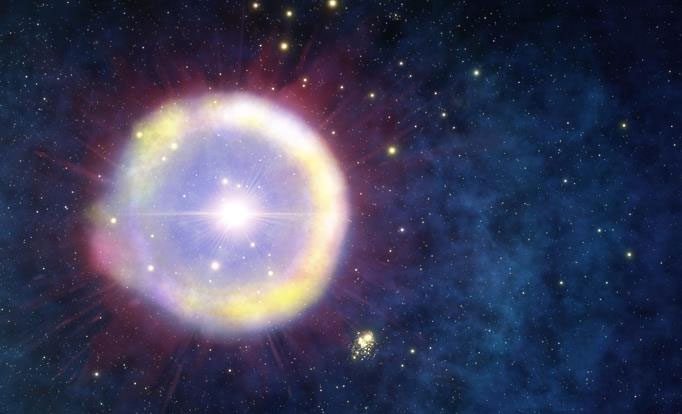Scientists have discovered evidence of the first monster stars in the universe—approximately 13.1 billion years old—that have exploded and may have become part of us and all living beings.
By analyzing the remarkable light from clouds surrounding a distant quasar, a team of researchers from Japan, Australia, and the United States found a “special mix of heavy elements”, which serves as evidence for the existence of a hypothetical type of “monster”: First-generation giant stars.
The Science Alert website cites explanations from the research team: All stars we can see with the naked eye are classified as Population I or Population II, depending on their age; with Population II stars being younger and containing more heavy elements than Population I.

Graphic depicting a quasar belonging to Population III – (Image: NOIRLab/NSF/AURA/J. da Silva/Spaceengine).
However, there remains Population III—a hypothetical class of stars that is older and coincides with the existence of the universe itself. To observe them, humans must look at images from over 13 billion years ago—essentially viewing something that is 13 billion light-years away, as the light from it takes that long to reach Earth, giving humanity the chance to “see” into the past.
This is a challenging task, but by analyzing spectral data, the research team has indirectly captured the light of a quasar that is 13.1 billion years old.
According to two of the lead authors of the study—astronomers Yuzuru Yoshii and Hiroaki Sameshima from the University of Tokyo, Japan—they calculated the abundance of heavy elements released by the quasar into the surrounding clouds using spectral intensity, discovering a magnesium-to-iron ratio that is “ten times” that of our Solar System. Several other heavy elements with unique ratios were also identified.
From the materials emitted by the clouds surrounding the quasar, it can be determined that this quasar was a supernova, meaning it was a dead star that exploded into brilliant light, much brighter than a typical star. Quasar is the term used to describe such entities—something powerful, akin to a star but not quite a star.
This dead star is significantly brighter than ordinary stars, which has been documented. Moreover, the composition of elements it possesses has led to another hypothesis: they “pumped” a series of elements into the primordial universe, which was initially composed of hydrogen, helium, and a little lithium.
The heavy elements produced by Population III stars spread throughout the cosmos, and after many evolutionary processes in the universe, they have integrated into the bodies of rocky planets like Earth, as established by numerous previous studies.
And the elements belonging to this ancient “monster” star lineage are indeed the seeds of life, providing an answer to the timeless question: Where do we come from?
This study has just been published in The Astrophysical Journal.


















































